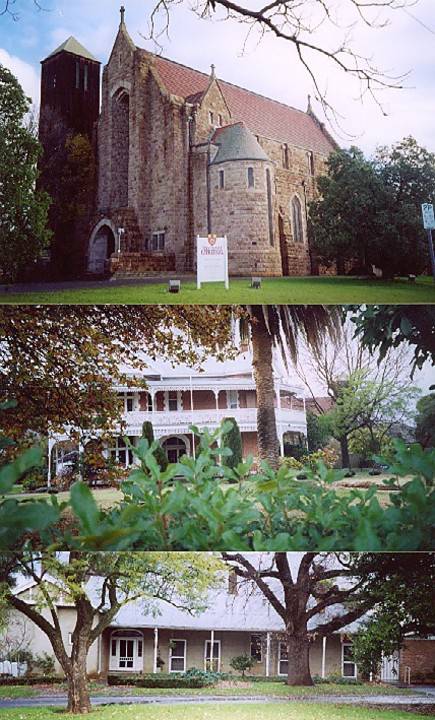| Back to search results » | Back to search page » |
|
Holy Trinity Anglican Cathedral Precinct
LocationBordered by Docker, Ovens and Cusack Streets,, WANGARATTA VIC 3677 - Property No B7229
File NumberB7229LevelState |
|
Statement of Significance
What is significant? The first Anglican Church in Wangaratta, Trinity Church, was built on the site of the present Cathedral in 1856, and a rectory (the present Deanery) was built at the same time. The Diocese of Wangaratta was formed in 1901 and the Bishop's Lodge was built in 1904. The first section of the Cathedral, consisting of the western half of the nave, was begun in 1908. The second section, consisting of the Lady Chapel, Chancel, sanctuary, sacristy and vestries, was added in 1922-24. The architect for these sections was Walter Butler and the builder was W McKnockiter. The third stage, the completion of the nave and the addition of the baptistery, was designed by Louis Williams, and built in 1961-5 by L H Brown Williams and Joseph Smith. The fourth section, a tower intended to be built to the south of the entrance, where the timber bell tower now stands, remains incomplete. The temporary timber bell tower, begun in 1983, contains bells cast in 1806, making them the oldest peal of bells in Australia. The Close first appeared c1939, its houses were built between 1939 and 1950, and were used by staff and close associates of the Cathedral. The gates at each end of The Close were erected in 1963 and 1975. The War memorial Garden in front of the Cathedral contains a Boer War monument and a monument to those who died in WWI, WWII and the Vietnam War.
The Cathedral precinct consists of buildings and grounds along both sides of The Close, a short gated road curving around the Cathedral between Ovens and Docker Streets. The precinct includes the Cathedral on one side of The Close; seven brick houses along the other side; the Deanery adjacent to the Cathedral; The Bishops's Lodge, on the corner of Ovens and Cusack Streets; and the War Memorial Gardens on the corner of Docker and Ovens Streets. The Holy Trinity Cathedral at Wangaratta is an Arts and Crafts Gothic style church of rough-cut local pink granite with a detached timber bell tower. It is one of the finest twentieth century churches in Australia. The interior is of local red brick with geometric patterning in dark brown. It contains the fine Willis organ, a white marble pulpit also designed by Walter Butler, and fine windows. Along The Close are eight brick houses, including the Archdeacons' House, the Choirmaster's House, Holy Trinity House (a former boys' hostel), and The Bishop's Registry or the Diocesan Offices. The Deanery is adjacent to the cathedral, and the nearby two storey brick Bishop's Lodge is reached by a footpath leading off The Close. There are fine gardens and some superb specimen trees at the Bishop's Lodge and throughout the Close. The low front walls are mostly formed from blocks of local granite, said to be from the original church building.
How is it significant? The Holy Trinity Anglican Cathedral precinct at Wangaratta is significant for architectural, historical and social reasons at a State level. The Boer War and WWI monuments are significant for historical and social reasons at a local level.
Why is it significant? The Holy Trinity Anglican Cathedral at Wangaratta is architecturally significant as the first purpose-built rural Anglican cathedral to be completed in Victoria, as the only cathedral built in Victoria in the twentieth century, as an exceptional Arts and Crafts Gothic style church, and as an important example of the work of the prominent Victorian architects Walter Butler and Louis Williams. The Close is architecturally significant as the only known example in Australia of a cathedral close. The detached timber bell tower is an unusual modern example of this building type.
The Cathedral precinct is historically significant as a complex of buildings that demonstrates the importance of the Anglican church in Wangaratta. The bell tower also holds the oldest peal of bells in Australia (1806). The Boer War and WWI Memorials are historically significant as a reminder of the sacrifice made by local men in wars overseas.
The Cathedral is socially significant as a symbol of diocesan identity in north-east Victoria, and as the centre of Anglican religious practice in the region since the proclamation of the diocese in 1901. The Boer War and WWI & WWI Memorials are socially significant as the focal point of individual and community remembrance, and for Anzac Day ceremonies in Wangaratta.
Classified: 08/09/2004
Group
Monuments and Memorials
Category
Monument




